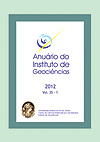Fractionation crystallisation and continental crust assimilation by the felsic alkaline rock magmas of the state of Rio de Janeiro, Brazil
DOI:
https://doi.org/10.11137/2012_2_84_104Abstract
This paper presents a general model for the magmatic evolution for the felsic alkaline rocks of the State of Rio de Janeiro, Brazil. The rocks are meta-alkaline nepheline syenite, alkaline syenite, phonolite, and trachyte of potassic and ultrapotassic series. The compositional variation diagrams indicate the fractionation crystallisation of clinopyroxene, amphibole, titanite, ilmenite, and apatite. The magmatic fractionation for the mafic and intermediate alkaline rocks is characterised by the crystallisation of leucita and alkaline feldspar, and for the felsic alkaline rocks, of leucita and alkaline feldspar. By means of fractionation crystallisation, the felsic alkaline magma changes its composition from meta-alkaline to peralkaline and from potassic to sodic. The SSI diagram (silica saturation index) for the felsic alkaline rocks presents a linear trend crossing over the thermal divide, pointing out a strong effect of continental crust assimilation. The magmatic evolution occurs in three stages: 1) Leucite crystallisation; 2) Alkaline feldspar and nepheline crystallisation; 3) Continental crust assimilation and consequent transformation of the silica-undersaturated composition into oversaturated one. The assimilation rate is high, reaching up to 54%. The assimilation events took place during the Stage 2, which suggests magma super-reheating and consequent wall rock partial melting, proposing the origin of alkaline syenite and trachyte magmas of thermodynamically unstable composition.Downloads
Download data is not yet available.
Downloads
Published
2012-12-01
How to Cite
Sichel, S. E. (2012) “Fractionation crystallisation and continental crust assimilation by the felsic alkaline rock magmas of the state of Rio de Janeiro, Brazil”, Anuário do Instituto de Geociências. Rio de Janeiro, BR, 35(2), pp. 84–104. doi: 10.11137/2012_2_84_104.
Issue
Section
não definida
License
This journal is licensed under a Creative Commons — Attribution 4.0 International — CC BY 4.0, which permits use, distribution and reproduction in any medium, provided the original work is properly cited.















